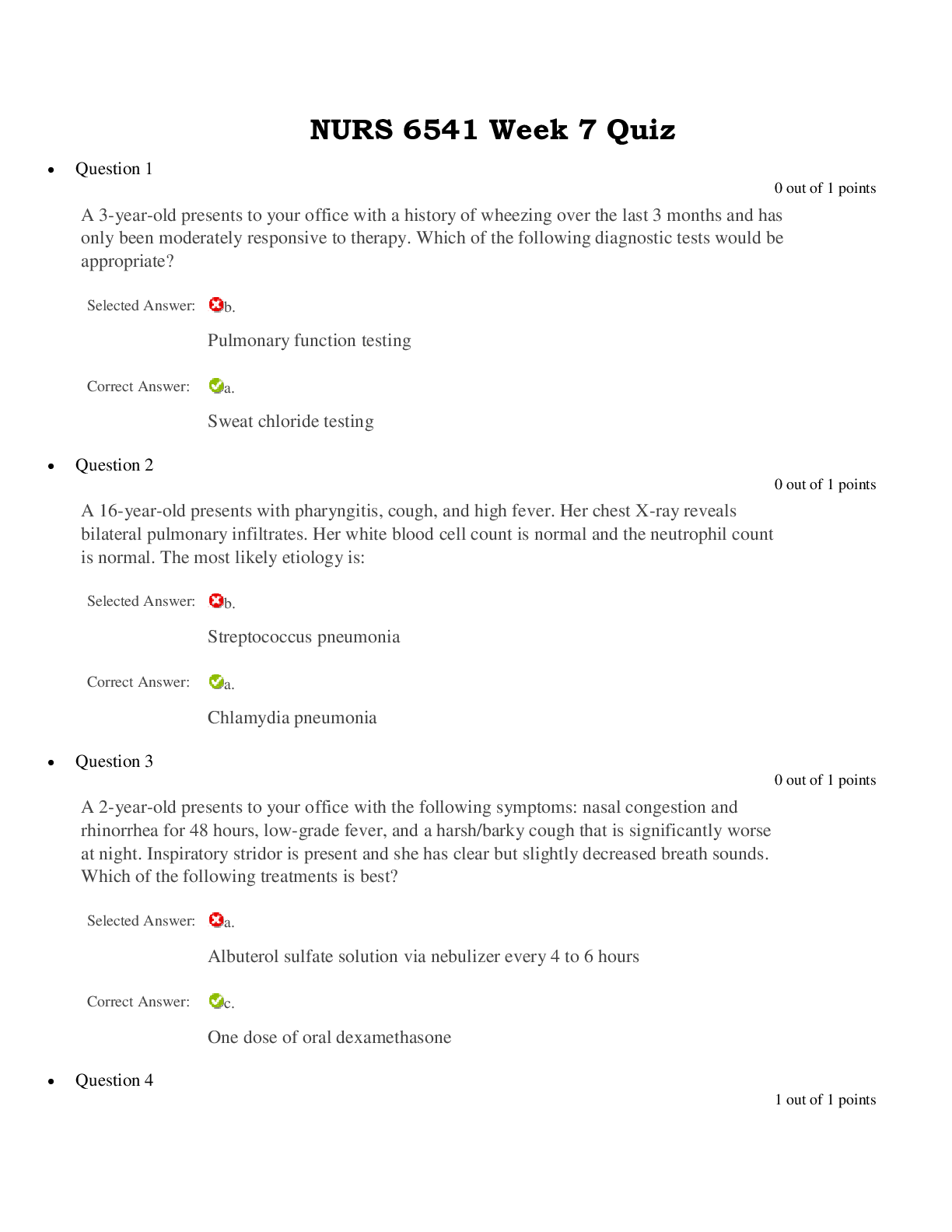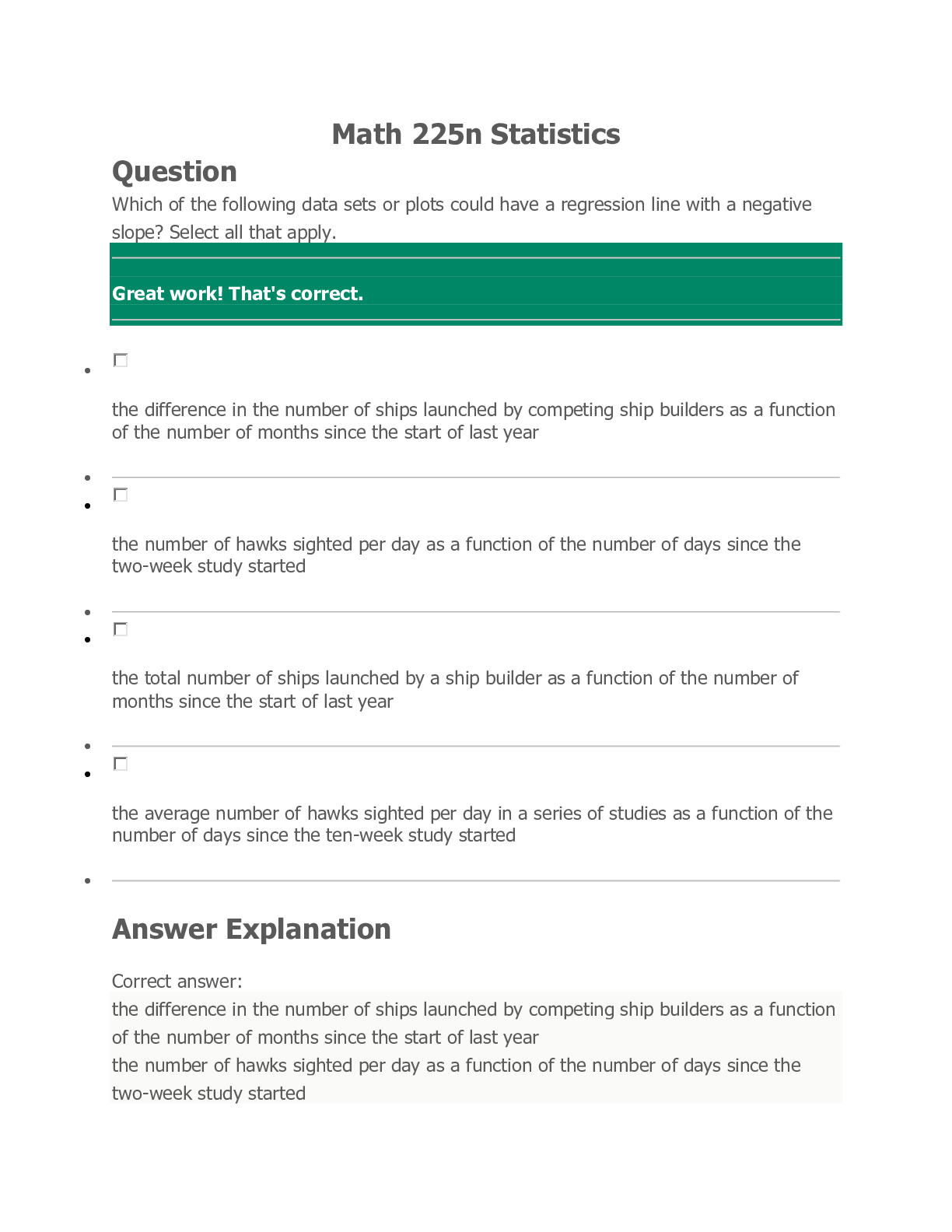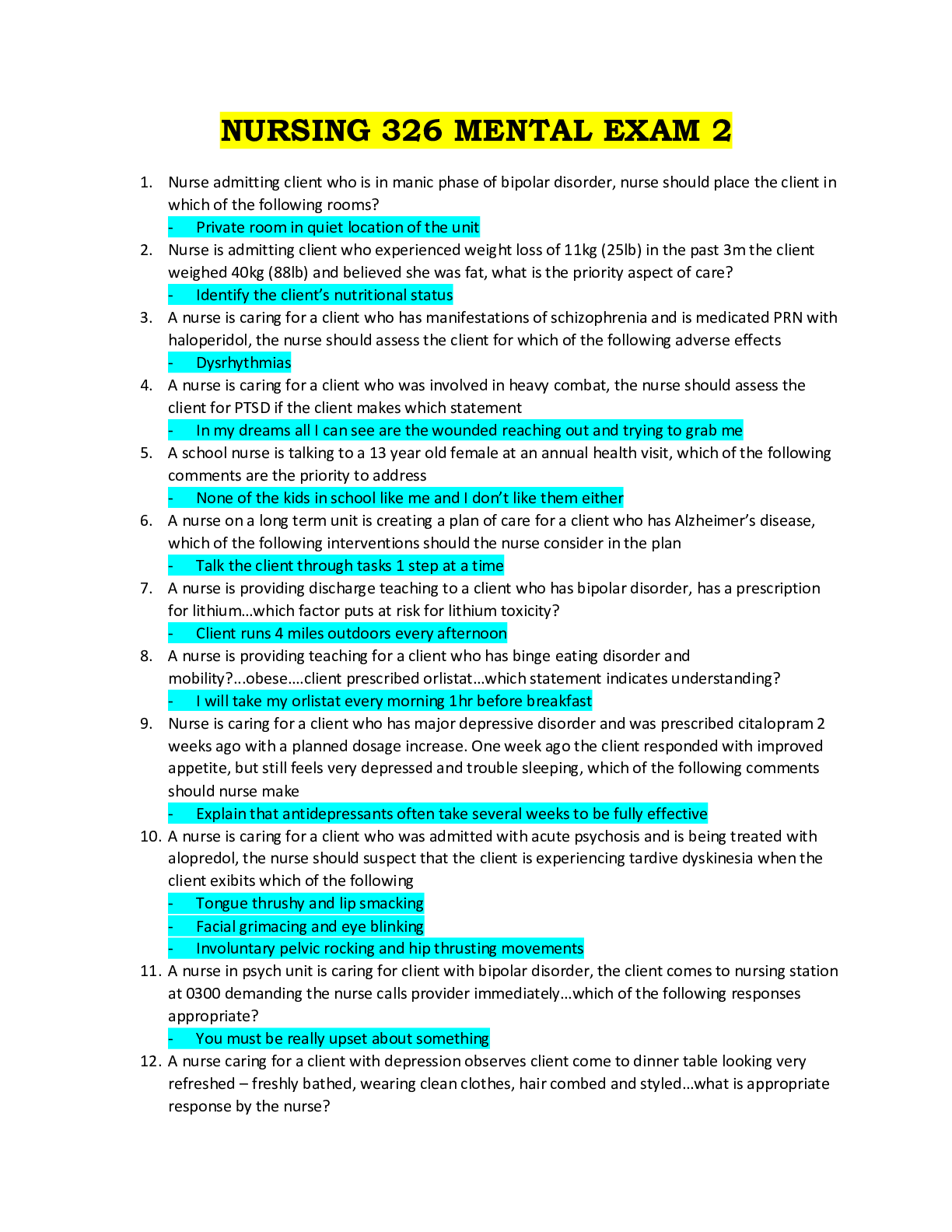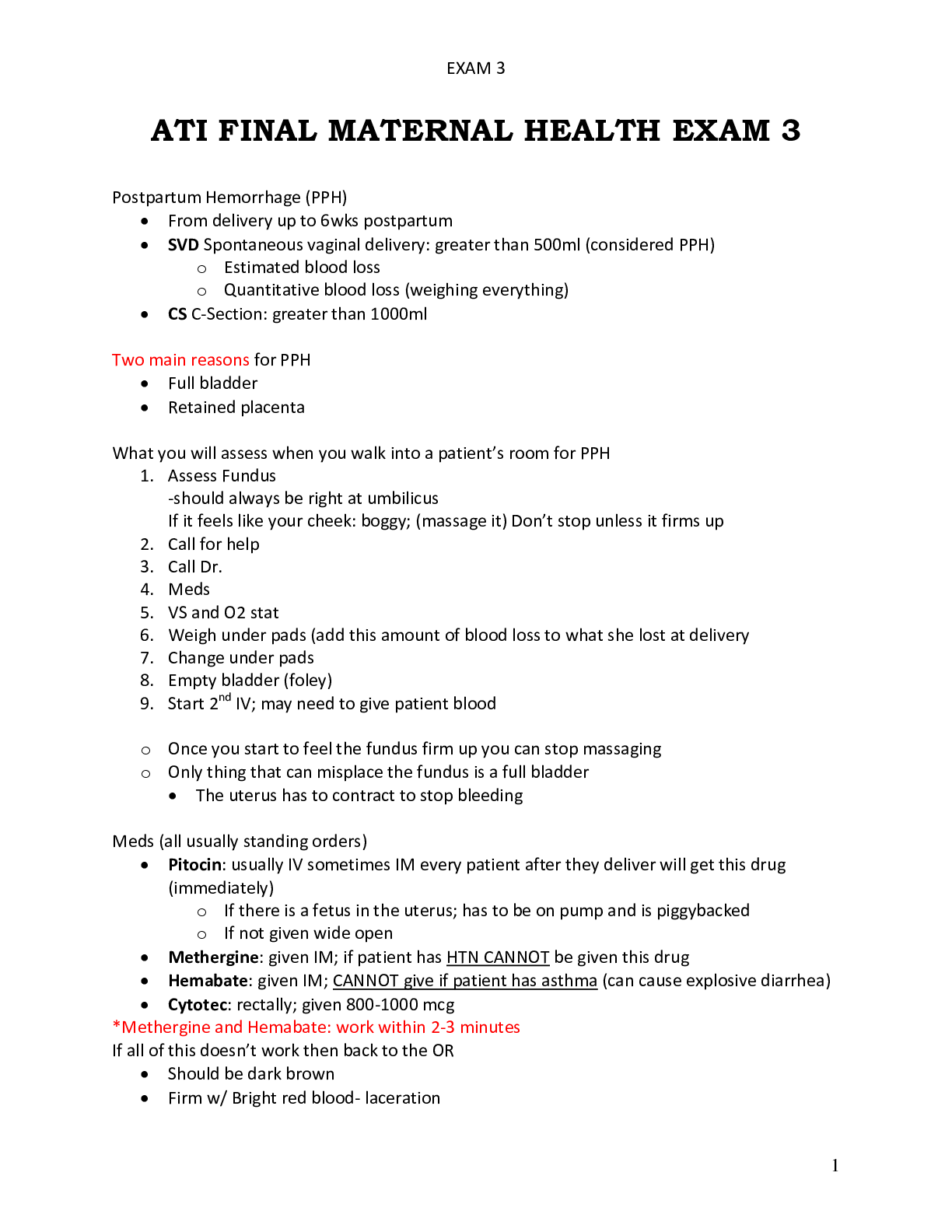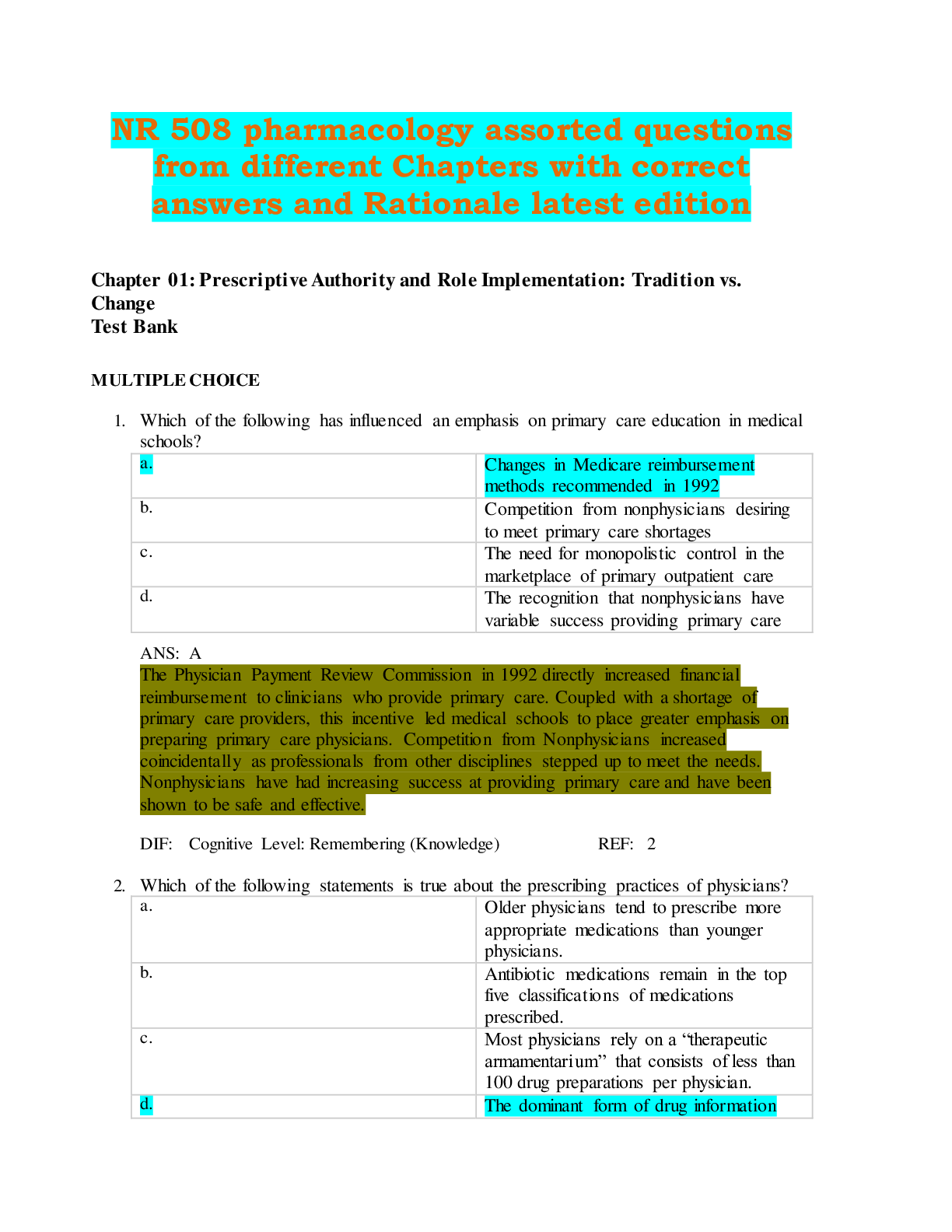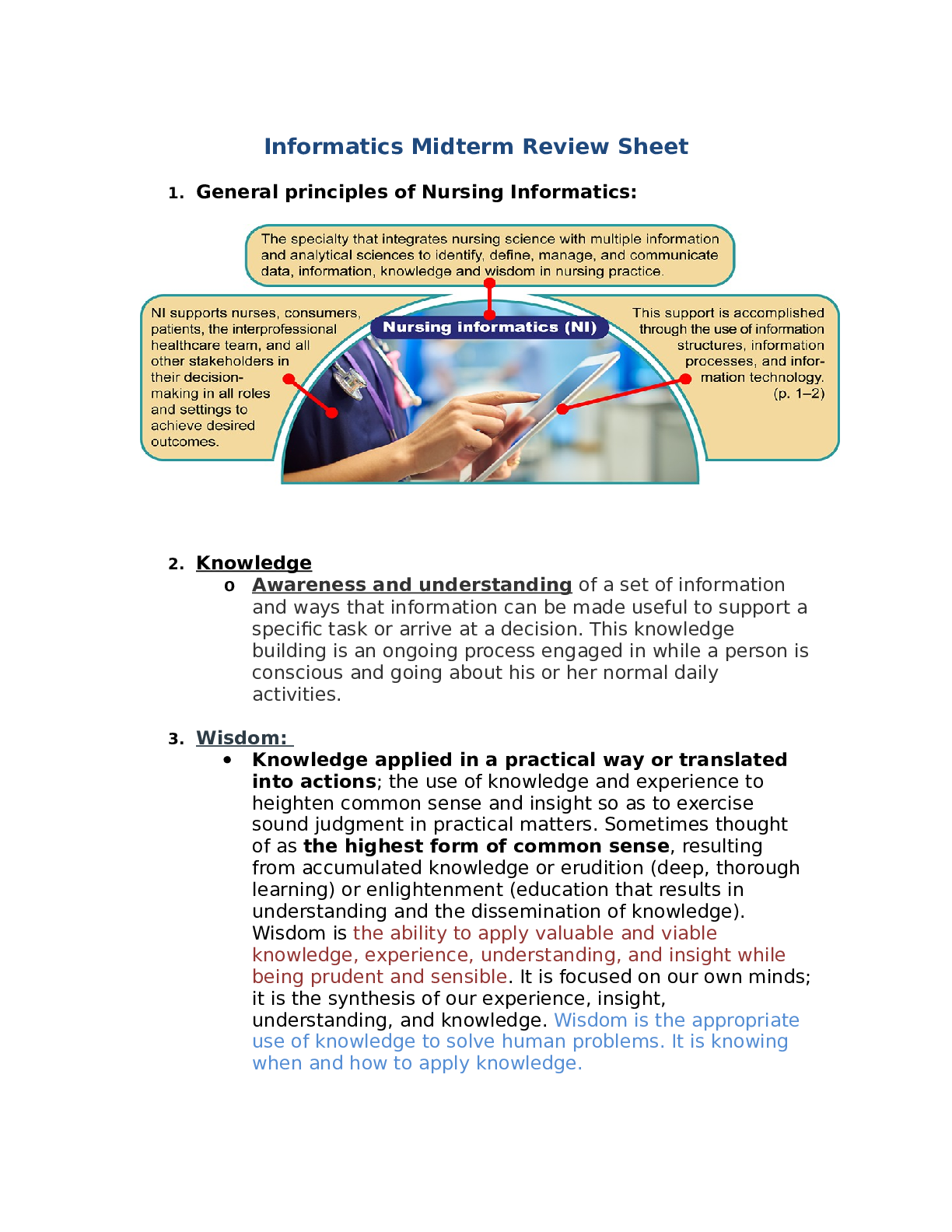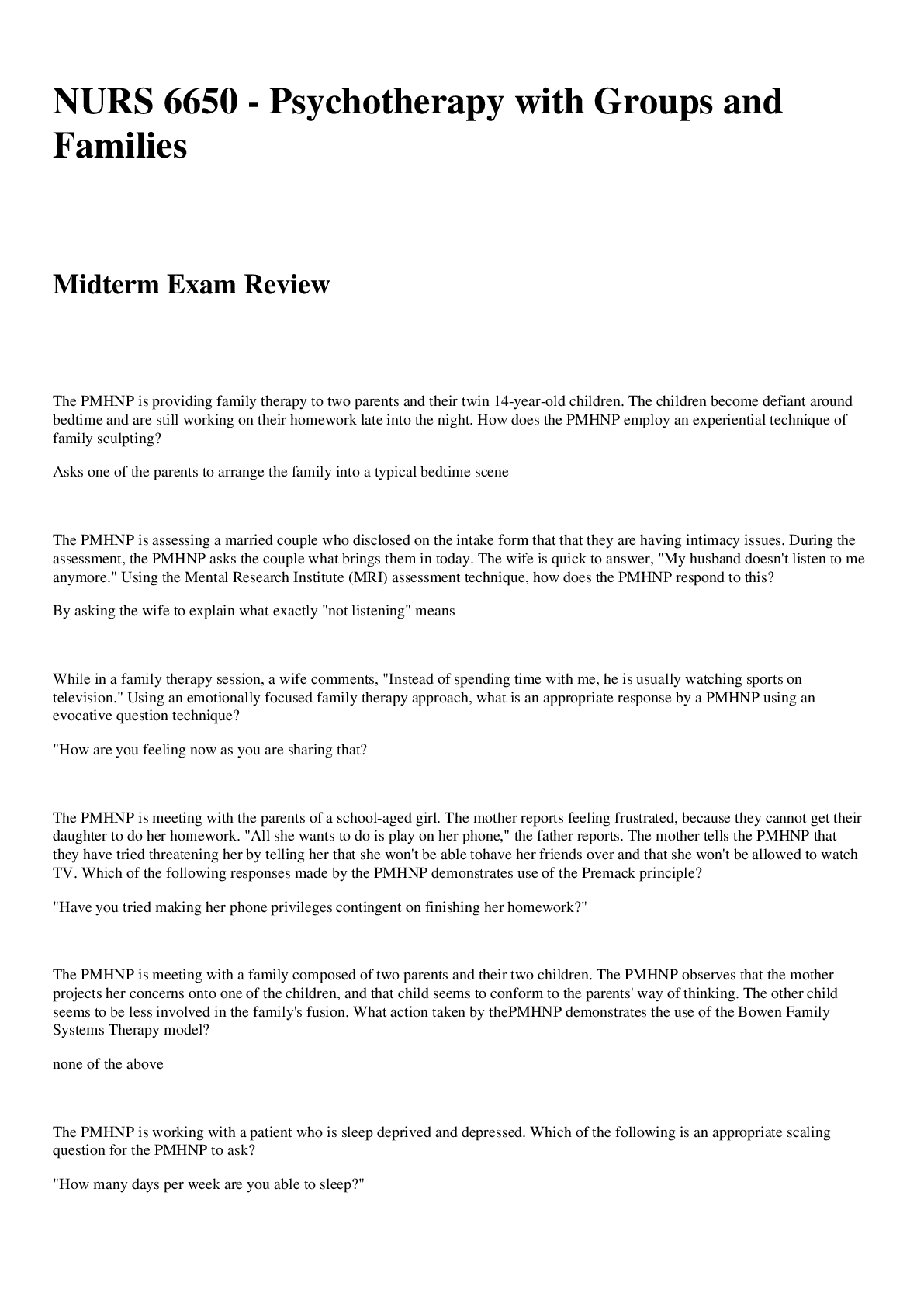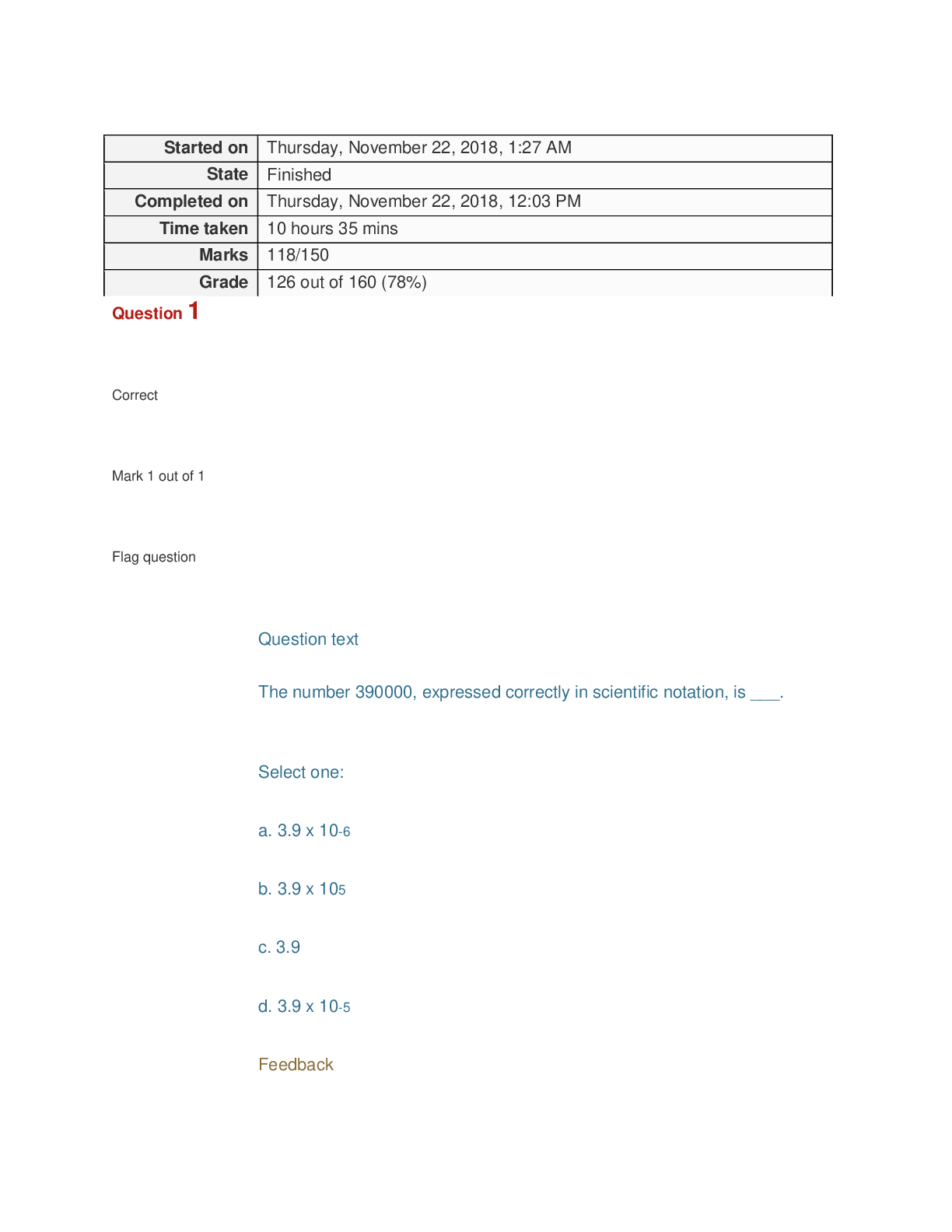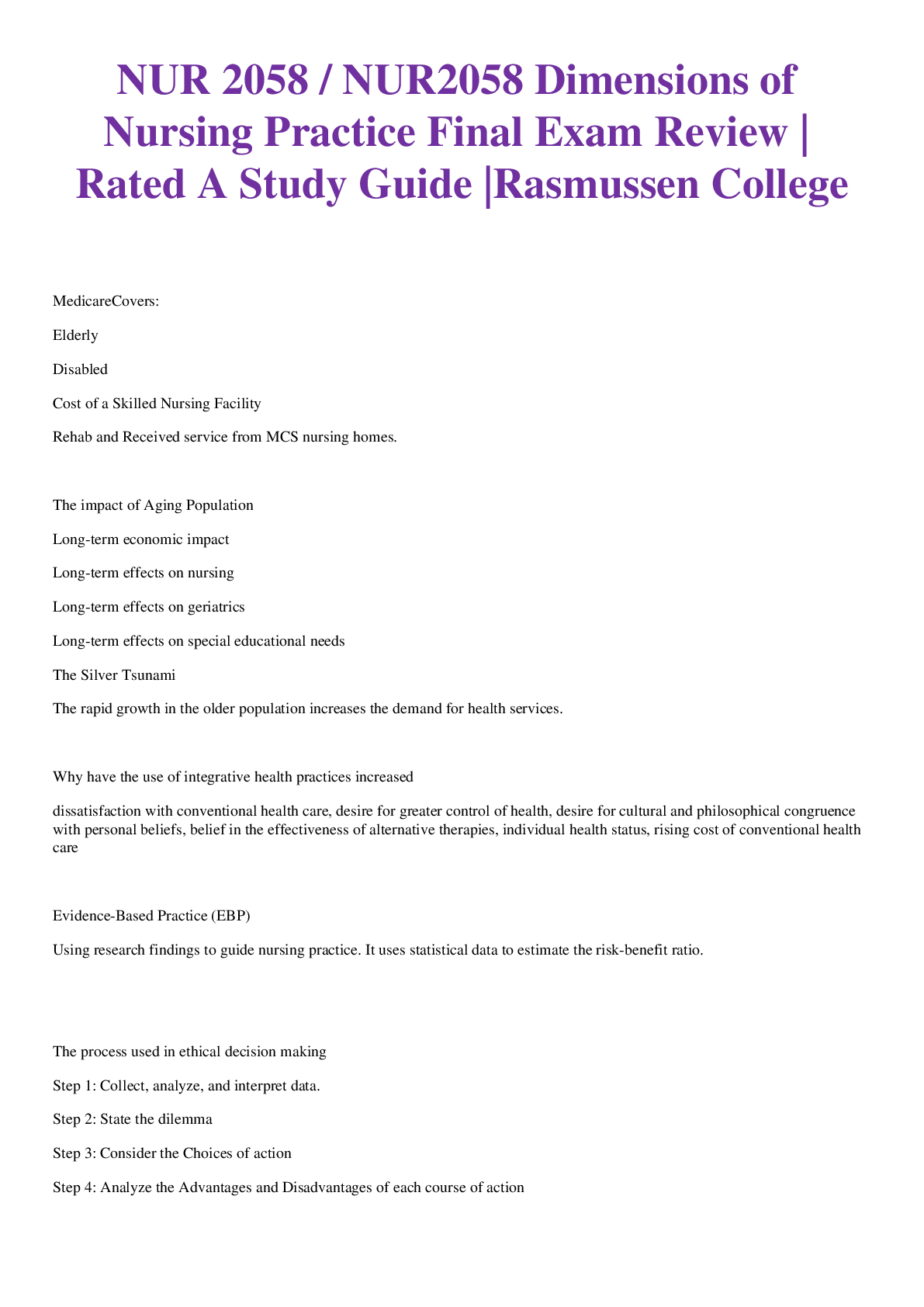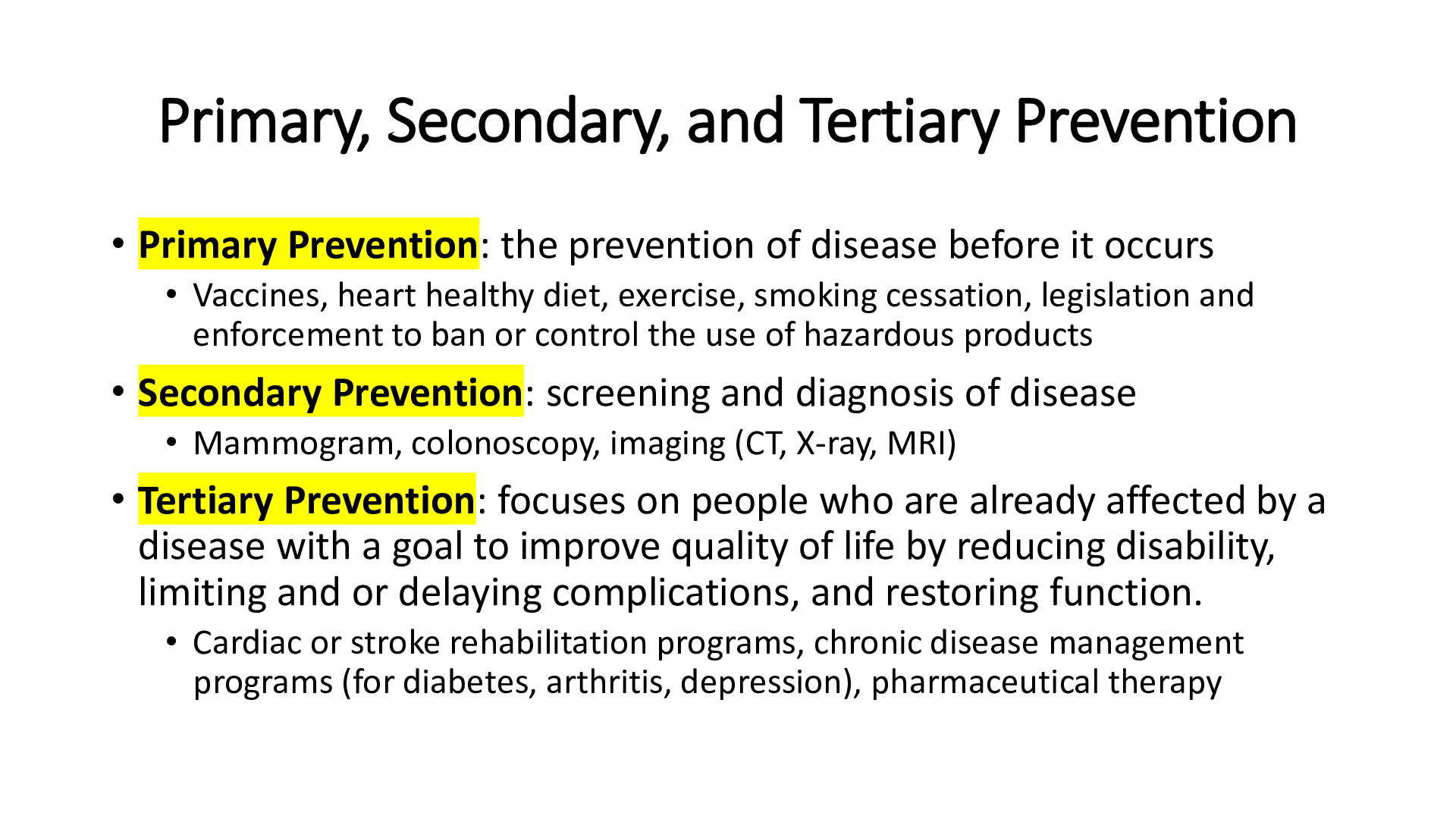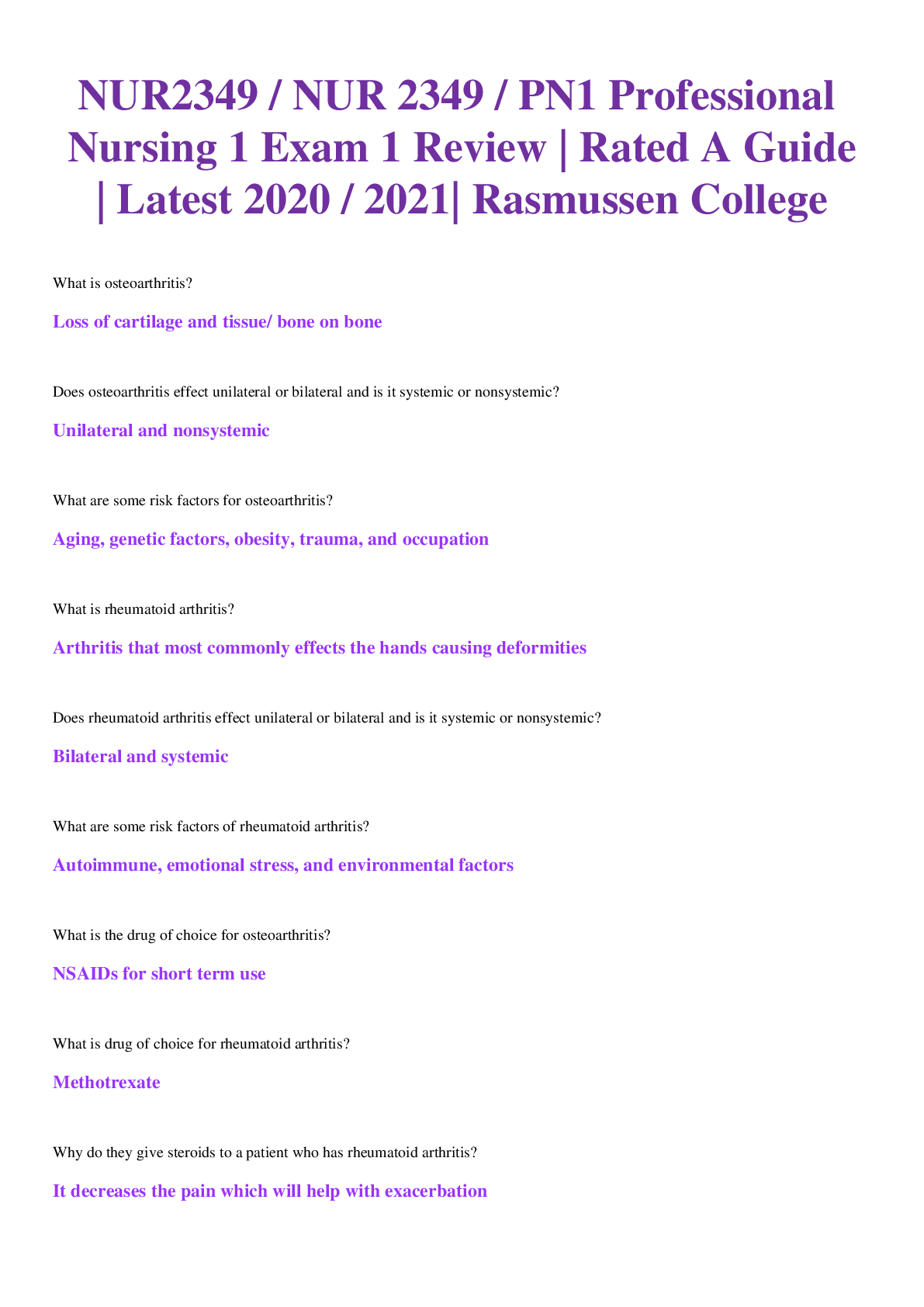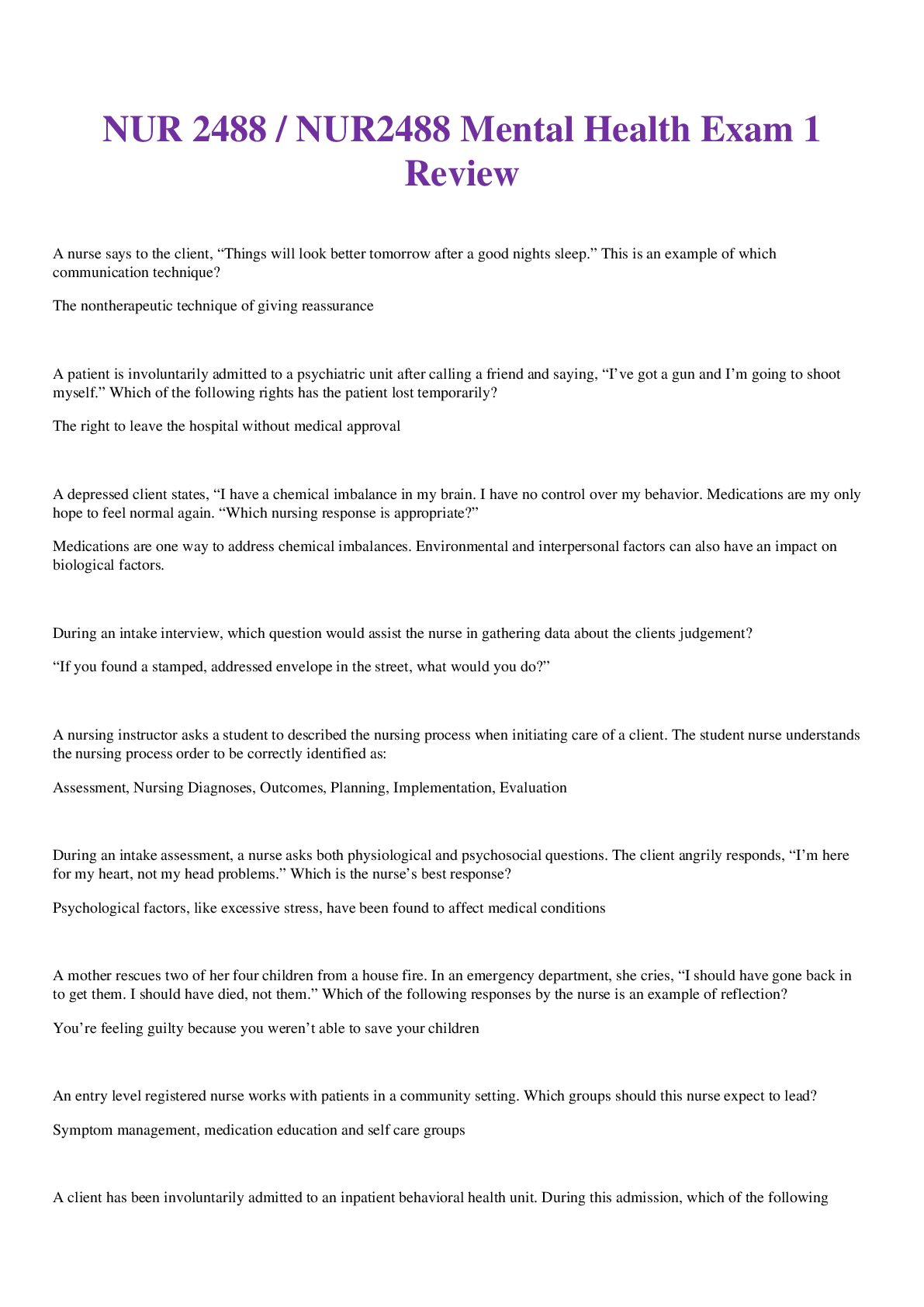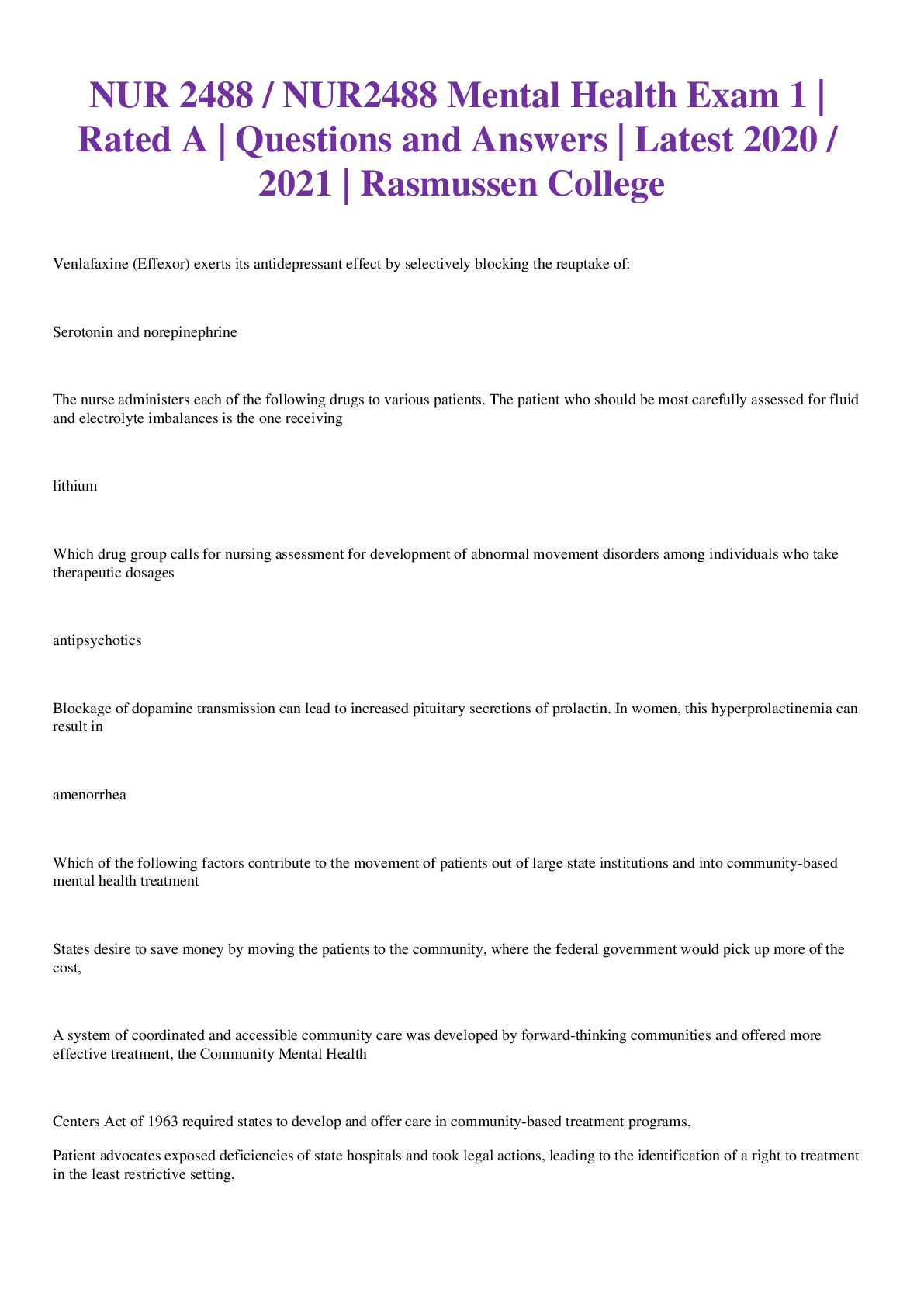BioChemistry > EXAM REVIEW > BIOCHEM C785Biochemistry Readiness Check I (All)
BIOCHEM C785Biochemistry Readiness Check I
Document Content and Description Below
Biochemistry Readiness Check The 2nd OA Readiness Check is designed to give you additional practice with new assessment-style questions to help prepare for success on the OA. Thus, please try to mi... mic exam-like conditions by taking the test in one <2 hr sitting without any study aids apart from your whiteboard/scrap paper. Note: Responses cannot be edited. You will be able to see the results and feedback after submitting the test. A score of 70% is required for OA approval. If you score below 70%, please speak with a Course Instructor via appointment to discuss next steps prior to retaking this test. Points: 54/67 1 What is the complementary sequence to 3’ ATG CGA ATA 5’? (1/1 Points) 3’ TAT TCG CAT 5’ The correct answer is 3' TAT TCG CAT 5'. Remember complementary means “Matching or Pairing” You have to remember to pay attention to your numbers as well as your letters (A-T, G-C, 5'-3'). The correct answer is 3’ ATG CGA ATA 5’ (original sequence) 5’ TAC GCT TAT 3’ (complementary sequence) But we asked for it in the 3’ direction, so mirror answer to give correct answer: 3’ TAT TCG CAT 5’ 3’ TAC GCT TAT 5’ 3’ GAT AGC ATA 5’ 5’ ATA AGC GTA 3’ 2 Which amino acid sequence would result from this Coding DNA strand? 3’ ATG CAG ATA 5’? (0/1 Points) Tyr Val Tyr The correct answer is Ile Asp Val. We are starting at the coding strand, and have to remember the relationship between coding DNA and mRNA. These two strands are noncomplementary and parallel. So we copy the coding strand , change T ---> U, and then write the mRNA sequence: 3’ ATG CAG ATA 5’ coding 3’ AUG CAG AUA 5’ mRNA Mirror by changing orientation: 5’ AUA GAC GUA 3’ Read chart Ile Asp Val (chart is in direction of 5' ---> 3') If you chose Tyr Val Tyr, this answer is incorrect because this is the amino acid sequence that results from the mRNA 5' UAC GUC UAU 3' which would have been complementary to the given coding strand. Coding DNA is non-complementary and parallel to mRNA. Ile Gln IleIle Asp Val Leu His Lys 3 Which amino acid sequence would be made from this template DNA strand? 5’ TAT TAC CGA 3’? (1/1 Points) Tyr Tyr Arg Ile Met Ala Ser Val Ile The correct answer is Ser Val Ile because 5’ TAT TAC CGA 3’ template is complementary and antiparallel so 3’ AUA AUG GCU 5’ but it is in the wrong orientation, so mirror 5’ UCG GUA AUA 3’ and read the chart Ser Val Ile Ser His Gln 4 Which of the following are the correct components for a PCR reaction? (1/1 Points) dNTPs, Primer, RNA Polymerase, template RNA dNTPs, Primer, DNA Polymerase, template DNA The correct answer is dNTPs, Primer, DNA Polymerase, template DNA. Notice that all components are about DNA. The Primer is even a DNA Primer. ATP, Primer, mRNA polymerase; template mRNA Acetyl CoA, RNA primer, DNA Ligase, Template phosphate 5 Assuming 100% reaction efciency, how many DNA copies will be produced after 5 PCR cycles, if we begin with 1 DNA template? (1/1 Points) 16 32 The correct answer is 32. 2x2x2x2x2=32 64 10 6 Which of the following would represent a silent mutation if this is the original sequence: 5’ AUC GUA ACA 3’? (1/1 Points) 5’ AUC GGA ACA 3’ 5' AUA GUA ACA 3' The correct answer is 5' AUC GUA ACA 3' Ile Val Thr5’ AUG GUA ACA 3’ 5’ AUC GCA ACA 3’ 7 If the original coding sequence is 5’ CGA TAC TTC AGA 3’ and it is mutated to 5' CGA TAT TTC AGA 3', what type of mutation would have taken place? (0/1 Points) Silent Missense The correct answer is silent mutation. The nucleotide sequence changes, but it codes for the same amino acid. The coding sequence 5' TAC 3' corresponds to the mRNA sequence 5' UAC 3' (Tyr), and the coding sequence 5' TAT 3' corresponds to the mRNA sequence 5' UAU 3' (Tyr). Since the C changed to at T, this is a point mutation. If the point mutation results in the same amino acid in the new sequence as in the original sequence, the point mutation is a silent mutation. Nonsense Insertion 8 This learning objective is now tested in a different WGU course than Biochemistry. Please select True. True The correct answer is Option 1 because an autosomal dominant disorder would be inherited on numbered chromosomes, not sex chromosomes X or Y. Also, at least one dominant allele (yellow box) needs to be present for the individual to have the dominant disease. False 9 This learning objective is now tested in a different WGU course than Biochemistry. Please select True. True The correct answer is X- linked recessive because parents (carriers) do not have it (II-5- 6) but a child does (III-5). You will get the same result if you consider parents (carriers) (I-1-2), who do not have the trait, but a child does (II-3). A third option that gives the same result (X-linked recessive) is by considering parents (carriers) who do not have the trait (III-1-2), and their child does (IV-1). The pattern is recessive because the selected parents are carriers, and it is X-linked because only males have the trait. False 10 This learning objective is now tested in a different WGU course than Biochemistry. Please select True. TrueThe correct answer is 50%. Homozygous recessive: aa Heterozygous: Aa When you see "percentage" or "probability," think Punnett square. 50% of the children would be expected to be Aa, and 50% of the children would be expected to be aa. False 11 Which of the following describes an epigenetic change? (0/1 Points) Denaturation of template DNA to facilitate primer annealing. Increased methylation of the promoter region of a tumor suppressor gene in a developing fetus. Thymine dimer formation resulting from UV radiation. The correct answer is "Increased methylation of the promoter region of a tumor suppressor gene in a developing fetus." Mismatch mutation caused by mistakes made by DNA Polymerase during replication. 12 Rett syndrome is a brain disorder that occurs almost exclusively in females, causing severe defcits in language, learning, coordination and other brain functions. Decreased expression of the MECP2 gene causes Rett syndrome. Which of the following scenarios correctly describes how Rett syndrome could be developed? (0/1 Points) A DNA-binding protein blocks RNA Polymerase from binding to the promoter sequence, facilitating the transcription of the MECP2 gene. The answer is "Transcription factors are unable to bind to the transcription start site of the MECP2 gene because nucleosomes are tightly packed together." Think "increased space gives increased access and increased expression." Gene expression is increased when nucleosomes are widely spaced and transcription factors and RNA Polymerase are able to bind to the transcription start site of the gene. In this question, decreased expression is resulting from decreased space between the nucleosomes, so the RNA Polymerase and transcription factors have decreased access to the transcription start site of the gene. If you answered, "A DNA-binding protein blocks RNA Polymerase from binding to the promoter sequence, facilitating the transcription of the MECP2 gene," this answer is incorrect. Transcription factors are proteins that bind to the promoter region on the 5' side of the gene to be expressed. The RNA Polymerase then binds to the transcription start site. Transcription factors are unable to bind to the transcription start site of the MECP2 gene because nucleosomes are tightly packed together. Transcription activators cause nucleosomes to separate, exposing the MECP2 gene. RNA Polymerase binds to the MECP2 gene and begins translation. 13 What happens when the incorrect base is added during the synthesis of a DNA strand in DNA replication? (1/1 Points)The homologous chromosome is used to replace the incorrectly added base with the correct one. DNA Polymerase removes the incorrect base and adds in the correct base. The correct answer is "DNA Polymerase removes the incorrect base and adds in the correct base." DNA Polymerase repairs mismatch errors that occur during DNA replication. Thymine dimers occur. Distortion of the double helix occurs and is repaired by RNA Polymerase. 14 What is the correct defnition of nucleotide excision repair? (1/1 Points) Removal of a single damaged nucleotide Damage to a few or several nucleotides are identifed, then many nucleotides are removed and all are replaced to repair the DNA segment The correct answer is "Damage to a few or several nucleotides are identifed, then many nucleotides are removed and all are replaced to repair the DNA segment." In nucleotide excision repair, several nucleotides are removed whereas, in BER (base excision repair), a single nucleotide is removed. Required when there are breaks in the double stranded DNA strand which causes discontinuity in both strands Insertion of a thymine dimer 15 If arginine is mutated to leucine within a protein, how would the structure of the protein be affected? (1/1 Points) Ionic bonds will continue to form, allowing the protein to fold as normal. Hydrophobic interactions will continue to occur resulting in normal folding. Ionic bonds will no longer form, potentially causing the protein to misfold. The correct answer is "Ionic bonds will no longer form, potentially causing the protein to misfold." Since arginine is a positively-charged amino acid, it would have formed an ionic bond with a negatively-charged amino acid in the protein. Leucine is not charged and is hydrophobic, so it will not form this same ionic bond, and could lead to protein misfolding. Hydrophobic interactions will be broken, potentially causing aggregation. 16 Which pair of amino acids below could bond together to stabilize the tertiary structure of a protein? (0/1 Points) Option 1 Option 2The correct answer is "phenylalanine" and "methionine." Phenylalanine and methionine are both nonpolar (hydrophobic) amino acids, and they interact in the core of the protein through hydrophobic forces. Option 3 Option 4 17 On a summer's day, I was cleaning my garage. My cat Sophie was out with me, and got into a bottle containing a strong reducing agent. Of course I took her straight to the vet. What type of amino acid bonds would be disrupted by exposure to the strong reducing agent? (1/1 Points) Hydrophobic interactions Hydrogen bonds Disulfde bonds The correct answer is covalent (disulfde) bonds. Hydrophobic interactions are disrupted by heat. Hydrogen bonds and ionic bonds are both disrupted by pH and by salt. Ionic bonds 18 What type of bond can the amino acids below form to stabilize the tertiary structure of a protein? (0/1 Points) Ionic bond The correct answer is "hydrogen bond." Each of the amino acids shown is a polar amino acid, and polar amino acids interact through hydrogen bonds. The NH combined with the C=O in glutamine places this amino acid side chain into the polar category. The OH bond in serine places this amino acid side chain into the polar category. Hydrophobic interaction Hydrogen bond Disulfde bond 19 What type of reaction forms the primary structure of a protein? (1/1 Points) Activation energy Enzymes Dehydration The correct answer is a dehydration reaction. When two amino acids join together, they lose water. One loses an O from a carboxyl group, and the other loses two Hs from its amino group, to give a loss of water. See Study Guide Step 7 for review. Hydrolysis 20Myoglobin is an oxygen storage protein and exhibits a hyperbolic curve in an oxygen saturation graph. What is the highest level of protein structure exhibited by myoglobin? (1/1 Points) Primary Secondary Tertiary The correct answer is "tertiary." Myoglobin is made from one polypeptide chain, or is a "single subunit" protein. Myoglobin's tertiary structure gives it its functional 3D shape. A hyperbolic curve indicates a "single subunit" protein. A sigmoidal curve indicates a quaternary (multi-subunit) protein. Quaternary 21 What level of protein structure involves alpha helices and beta pleated sheets? (1/1 Points) Primary Secondary The secondary level has alpha helices and beta pleated sheets. Primary structure is formed by joining together amino acids through peptide bonds. Secondary structure is formed by hydrogen bonds between backbone amino acids. Tertiary structure is formed form interactions between amino acid side chains. Quaternary structure is formed from interactions between amino acid side chains. Proteins with quaternary structure have two or more subunits. Tertiary Quaternary 22 Glutamine is located at position 13, of a protein, and forms a hydrogen bond with the amino acid at position 89. What would happen if the amino acid at position 89 was mutated to alanine? (1/1 Points) Nothing, they will bind normally The hydrogen bond will no longer be formed, and the protein will be misfolded The correct answer is "The hydrogen bond will no longer be formed, and the protein will be misfolded. Glutamine is a polar amino acid (NH and also C=O), and alanine is a nonpolar (hydrophobic) amino acid (CH3), and so alanine will not interact with the polar amino acid glutamine. Nothing, they will form a hydrophobic interaction They will form a disulfde bond 23An elderly patient is diagnosed with Alzheimer’s Disease. Which of the following is most likely the cause of this neurological disorder? (1/1 Points) Disulfde bond formation by cysteine amino acids Iron defciency Aggregation of hydrophobic amino acids The correct answer is "Aggregation of hydrophobic amino acids." Alzheimer's disease results from abnormal protein aggregation in the brain. Ionic bonds formed by hydrogen bonding of amino acids 24 What type of interactions would be affected in a patient with diabetic ketoacidosis? (select all that apply) (0/1 Points) Hydrogen bonds Hydrogen bonds and ionic bonds are affected by a change in pH. Hydrogen bonds and ionic bonds are also affected by a change in salt concentration. Ionic bonds Hydrophobic interactions Disulfde bonds 25 Hydrogen bonds between backbone groups stabilize what level of protein structure? (1/1 Points) Primary Secondary The correct answer is "secondary." Primary structure is formed by joining together amino acids through peptide bonds. Secondary structure is formed by hydrogen bonds between backbone amino acids. Tertiary structure is formed form interactions between amino acid side chains. Quaternary structure is formed from interactions between amino acid side chains. Proteins with quaternary structure have two or more subunits. Tertiary Quaternary 26 What type of bond is found in the primary structure of a protein? (1/1 Points) Ionic Disulfde Charged PeptideThe correct answer is "peptide bonds." The primary structure is built by hooking together amino acids to make the amino acid backbone of the protein. The amino acids are joined together by peptide bonds. 27 Which of the following is true about protein structure and function? (0/1 Points) A protein has optimal function in its primary structure. All proteins carry out cellular functions when they have obtained their fnal quaternary structure. Ionic bonds between the backbone groups of amino acids stabilize a protein's tertiary structure. If you chose "All proteins carry out cellular functions when they have obtained their fnal quaternary structure, this answer is incorrect. If the word "all" is changed to "some," then the statement would be a true statement. All proteins have tertiary structure (made from one polypeptide chain), and only some proteins are built from the two or more subunits that give quaternary structure. If you chose "ionic bonds between the backbone groups of amino acids stabilize a protein's tertiary structure," this answer is incorrect. Ionic bonds form between amino acid side chains, not between backbone groups. In addition, although the ionic bonds can give some stability to the protein structure, the hydrophobic effect drives the formation of the core of a protein, which is the predominant contributing factor to the protein's tertiary structure. The hydrophobic effect primarily contributes to a single subunit protein's tertiary structure. 28 Frying an egg in a pan changes the egg white color, due to the protein ovalbumin, from translucent to white. Which bond or interaction is most likely to be disrupted within the Ovalbumin? (1/1 Points) Ionic bonds Hydrophobic interactions The correct answer is "Hydrophobic interactions." Heat will disrupt hydrophobic interactions. Ionic bonds are disrupted by changes in pH and by salt, and disulfde bonds are disrupted by reducing agents. Disulfde bonds None of the above 29 Which of the following statements correctly describes the difference between hemoglobin and myoglobin? (1/1 Points) Hemoglobin binds oxygen in a cooperative manner, while Myoglobin binds oxygen with a relatively higher afnity and stores oxygen. The correct answer is, "Hemoglobin binds oxygen in a cooperative manner, while Myoglobin binds oxygen with a relatively higher afnity and stores oxygen." Hemoglobin has 4 subunits and binds oxygen in a cooperative manner. Cooperativity means that asone molecule of oxygen binds to hemoglobin, the shape of hemoglobin changes to make it easier to bind subsequent molecules of oxygen. Myoglobin’s job is to store oxygen, so it binds to oxygen with a high afnity and stores it. Hemoglobin has tertiary structure, while Myoglobin has quaternary structure and binds oxygen in a cooperative manner. Hemoglobin stores oxygen and Myoglobin delivers oxygen to oxygen-deprived muscle tissue. Myoglobin is bound by 2,3-BPG and changes into the T-state to deliver oxygen 30 Which of the following molecules binds directly to the iron in hemoglobin? (1/1 Points) CO2 Mg 2,3-BPG CO CO does bind directly to the iron in hemoglobin, taking the place of oxygen in subunit bound CO 31 Susie is 18 weeks pregnant with twins and was recently diagnosed with gestational diabetes. Susie’s twins are developing according to schedule and Susie hopes to carry the twins as close to full term as possible. Which statement below describes how a sufcient amount of oxygen is made available to Susie’s developing fetuses? (1/1 Points) Bicarbonate binds to Susie’s hemoglobin and stabilizes the T-state conformation, which favors the delivery of oxygen to the developing fetuses. 2,3-BPG binds to Susie’s hemoglobin and stabilizes the T-state conformation, which favors the delivery of oxygen to the developing fetuses. The correct answer is, "2,3-BPG binds to Susie’s hemoglobin and stabilizes the T-state conformation, which favors the delivery of oxygen to the developing fetuses." 2,3-BPG binds to hemoglobin and stabilizes the T-state which favors oxygen delivery. Carbon monoxide binds to Susie’s hemoglobin and stabilizes the R-state conformation, which increases the delivery of oxygen to the developing fetuses. Bicarbonate induces Susie’s hemoglobin to adopt a non-planar conformation and bind oxygen so that the developing fetuses are sufciently oxygenated. 32 Alex is preparing to run in his frst 5K. As he stretches, his muscles are producing ATP through aerobic metabolic pathways. A byproduct of a functioning citric acid cycle is carbon dioxide. How is this carbon dioxide removed from the body? (1/1 Points)Carbon dioxide is converted to bicarbonate and binds to hemoglobin, which shuttles the carbon dioxide to the lungs so that it can be exhaled out of the body. Carbon dioxide flows through the bloodstream to the lungs so that it can be exhaled out of the body. Carbonic anhydrase helps carbon dioxide stick to hemoglobin, which shuttles the carbon dioxide to the lungs. In the lungs, Carbonic Anhydrase converts carbon dioxide to a gas so that it can be exhaled out of the body. Carbonic anhydrase converts carbon dioxide to bicarbonate, which can flow through the bloodstream to the lungs. In the lungs, Carbonic Anhydrase converts bicarbonate back to carbon dioxide so that it can be exhaled out of the body. The correct answer is, "Carbonic anhydrase converts carbon dioxide to bicarbonate, which can flow through the bloodstream to the lungs." In the lungs, carbonic anhydrase converts bicarbonate back to carbon dioxide so that it can be exhaled out of the body.) CO2 is a waste product produced in the tissues from aerobic respiration. The CO2 is converted to bicarbonate (HCO3-) in the tissues as a way to shuttle CO2 to the lungs so that it can be exhaled out of the lungs. In the lungs, HCO3- is converted back to CO2, and CO2 is exhaled out of the body. 33 What occurs as the amount of hemoglobin saturated with oxygen increases? (1/1 Points) Hemoglobin adopts the T-state conformation and the heme groups become planar. Hemoglobin adopts the R-state conformation and the heme groups become planar. The correct answer is, "Hemoglobin adopts the R-state conformation and the heme group becomes planar." When hemoglobin binds oxygen (in the lungs) in changes into the R-state and the heme groups take on a planar shape. Think of hemoglobin as becoming relaxed as it binds more oxygen, just like you might if you stop and take a deep breath. Think CHART in the tissues, the opposite in the lungs: C for high CO2, H for high H+, A for acidity, R for release of oxygen, and T for T state, or benT heme. Hemoglobin adopts the T-state conformation and the heme groups become bent. Hemoglobin adopts the R-state conformation and the heme groups become bent. 34 During a morning run on the treadmill, the blood around muscle tissue becomes increasingly acidic. What happens to hemoglobin when it encounters this acidic muscle tissue? (1/1 Points) Hemoglobin will switch into the R-state and deliver oxygen Hemoglobin will bind and store oxygen Hemoglobin will switch into the T-state and deliver oxygen The correct answer is "Hemoglobin will switch into the T-state and deliver oxygen," because Hemoglobin switches into the T-state and delivers oxygen in the acidic (low pH) environment of exercising muscle tissue. Think CHART: C for high CO2, H for high H+, A for acidity, R for release of oxygen, and T for T state.Hemoglobin will switch into the R-state and bind oxygen 35 Based on the graph below, which of the following statements is true? (1/1 Points) The hemoglobin curve will shift to the right when there is a high concentration of H+ (protons) and the concentration of CO2 is high. The correct answer is, "The hemoglobin curve will shift to the right when there is a high concentration of H+ (protons) and the concentration of CO2 is high." A right shift in the hemoglobin curve correlates with a decrease in pH. At low pH, H+/proton concentration is high (this occurs in muscle tissue and tells hemoglobin to release oxygen). In the muscle tissue, at low pH, CO2 concentration is high because it is being produced by the muscles. Think CHART in the tissues, the opposite in the lungs: C for high CO2, H for high H+, A for acidity, R for release of oxygen, and T for T state, or benT heme. The hemoglobin curve will shift to the left when there is a high concentration of H+ (protons) and the concentration of CO2 is low. The hemoglobin curve will shift to the right when there is a low concentration of H+ (protons) and the concentration of CO2 is low. The hemoglobin curve will shift to the left when there is a high concentration of H+ (protons) and the concentration of CO2 is high. 36 If Enzyme 4, in the pathway below, were inhibited, which of the following would be true? (0/1 Points) The amount of A would decrease The amount of D would increase The correct answer is, "The amount of E would increase." If enzyme 4 is inhibited, then D will no longer be made, so C will be converted to E. Thus, E would increase. The amount of C would decrease The amount of E would increase 37 Describe what would happen if Enzyme 2 in the pathway below were inhibited. (1/1 Points) The amount of compound C would build up The amount of compound B would build up The correct answer is, "The amount of compound B would build up." When an enzyme is inhibited within a pathway, the enzyme’s substrate builds up and its subsequent products will decrease. The amount of compound D would increase The amount of compound A would decrease 38Which enzyme adds a phosphate group from ATP to a molecule? (1/1 Points) Kinase The correct answer is, "Kinase." A kinase ‘kindly’ adds a phosphate to a molecule and that phosphate can be removed by a phosphatase. Another way to remember this is that a kinase is "kind and giving" of a phosphate (from ATP). Phosphatase Acetyltransferase Dehydrogenase 39 Different compounds are needed to carry out essential cellular functions which maintain a physiological homeostatic balance. Enzymes catalyze reactions that produce these compounds and, in doing so, play a pivotal role in our bodies. Which statement below accurately describes how enzymes catalyze reactions within our cells. (1/1 Points) Enzymes increase the activation energy of a reaction. Enzymes decrease the reaction rate. Enzymes don’t change the reaction rate. Enzymes decrease the activation energy of a reaction. The correct answer is,. "Enzymes decrease the activation energy of a reaction." The activation energy is the amount of energy required to start the reaction. The lower the activation energy, the faster the reaction. 40 Asparagine endopeptidase has optimal activity at an acidic pH of 5.5 and a temperature of 98 degrees F. Under which of the following conditions would the catalytic activity of asparagine endopeptidase be highest? (1/1 Points) In brain tissue at pH 5 following traumatic brain injury The correct answer is, "In brain tissue at pH 5 following traumatic brain injury." Enzymes function optimally at their optimal temperature and pH. When the temperature, or pH, is substantially higher or lower than the optimal conditions for the enzyme, its catalytic activity decreases. Exposure to a temperature of 150 degrees F In renal tissue at pH 10 during alkalosis Exposure to a temperature of 20 degrees F 41An experimental compound, termed Drug X, can inhibit an enzyme by binding at a site that is distinct from the enzyme's active site. What type of inhibitor is Drug X? (1/1 Points) Competitive Non-competitive The correct answer is, "Non-competitive." An inhibitor that binds to a site other than the enzyme's active site (allosteric site) is a non-competitive inhibitor. Sequential Congruent 42 Alcohol dehydrogenase converts ethanol to acetoacetate. Which one of the compounds below could act as a competitive inhibitor of alcohol dehydrogenase? (1/1 Points) Option 1 Option 2 Option 3 The correct answer is Option 3, methanol. Alcohol dehydrogenase converts ethanol to acetoacetate, which means that ethanol is the substrate of the enzyme. A competitive inhibitor should have a similar structure as the substrate of the enzyme, since they both compete to bind to the active site of the enzyme. The structure of methanol is very similar to the structure of ethanol. Option 4 43 Zylezol is a fctitious drug that attenuates enzymatic activity. Over time, however, increased concentration of the enzyme’s substrate renders Zylezol ineffective. What kind of inhibition is used by Zylezol? (1/1 Points) Communicative Non-competitive Competitive The correct answer is, "Competitive." Competitive inhibitors compete with substrate to bind to the active site of an enzyme and can be out-competed by high concentrations of substrate. Saturated 44 Melatonin is a molecule, produced primarily in the pineal gland, which regulates the circadian rhythm. The following pathway depicts how theSerotonin is converted to Melatonin. Which of the molecules listed below is most likely to act as a feedback inhibitor of the pathway? (0/1 Points) Serotonin AcCoA The correct answer is, "Melatonin." Since melatonin is the product of the pathway, it can act as a feedback inhibitor by giving a message (feedback) to one of the frst enzymes in the pathway, and shut down the pathway. AcCoA is a coenzyme for the enzyme AANAT. AcCoA must be present in sufcient amounts for AANAT to function. It does not inhibit enzyme AANAT. N-acetyl-serotonin Melatonin 45 In the enzymatic cycle fgure below, identify the step that best demonstrates where the ‘induced ft model’ would occur. (1/1 Points) 1 2 The correct answer is Step 2. The induced ft model describes how substrate binds to the enzyme and forms an enzyme-substrate complex, in which the enzyme wraps itself around the substrate to convert the substrate into product. Step 2 represents the formation of the enzyme-substrate complex. 3 4 46 Which molecule would build up if Enzyme 2 were inhibited? (1/1 Points) A B The correct answer is B, because B is the substrate of enzyme 2. When an enzyme is inhibited within a pathway, the enzyme’s substrate builds up and its subsequent products will decrease. C E 47 How many ATP would we expect to produce from glucose after one full round of aerobic metabolism? (1/1 Points) 2 46 30 The correct answer is 30. Two ATPs are made from Glycolysis, four is the net loss in the Cori Cycle, 6 is how many ATP are used in the Cori cycle, and 30 is the correct answer. From glycolysis through the ETC, we will produce about 30 ATP. 48 What most accurately describes this reaction? (1/1 Points) Catabolic Anabolic The correct answer is "anabolic," because ATP is being built by adding a phosphate to ADP to make ATP. Ants like to build (anabolic). In a catastrophe, everything falls apart (catabolic). Dehydration Hydrolysis 49 ___________________ molecule enters the citric acid cycle and creates coenzymes such as ________ and _________that eventually enter the electron transport chain to produce ATP. (1/1 Points) Acetyl CoA; GTP, ATP Pyruvate; ATP, NADH Acetyl CoA; NADH, FADH2 The answer is " Acetyl CoA; NADH, FADH2". Acetyl CoA is the common molecule produced from Fatty acids, Glucose and some proteins that enter the citric acid cycle. The citric acid cycle in addition to some other molecules such as GTP, Carbon dioxide, produces NADH and FADH2 that move on to the electron transport chain to help produce ATP. Glucose; NADH, FADH2 50 Concomitant with electron transfer, complexes I, III and IV of the electron transport chain pump protons from the __________ to the _____________. (1/1 Points) Mitochondrial Matrix, Cytoplasm Cytoplasm, Mitochondrial Matrix Mitochondrial Matrix, Intermembrane Space The correct answer is "Mitochondrial matrix. Intermembrane Space," because the transmembrane complexes I, III and IV pump protons from the mitochondrial matrix into the intermembrane space to form the proton gradient.Intermembrane Space, Mitochondrial Matrix 51 If Metformin targets the efcacy of the Cori Cycle, what would be the possible changes to body pH? (1/1 Points) No change Blood will go acidotic The correct answer is, "Blood will go acidotic." Lactic acid can build up in the blood stream if the Cori cycle is not properly functioning, therefore dropping the blood pH and making it Acidotic. This occurs because the Cori cycle consists of glycolysis, fermentation, and gluconeogenesis. The fermentation step produces lactic acid from pyruvate, and the lactic acid then goes through the bloodstream to the liver. If gluconeogenesis is not working well, which is the step inhibited by metformin, the lactic acid can build up in the bloodstream, because it will not be used to make more glucose. Blood will go alkaline Temperature will increase 52 Fermentation allows the cell, under ____________ conditions, to continue the _____________ (name of cycle) and make __________________ amounts of ATP. (1/1 Points) Aerobic, citric acid cycle, large Anaerobic, citric acid cycle, large Aerobic, glycolysis, small Anaerobic, glycolysis, small The correct answer is, "Anaerobic, glycolysis, small." Fermentation allows the cell, under anaerobic conditions, to continue glycolysis and make small amounts of ATP. The ATPs are made in glycolysis, not in fermentation. 53 How many rounds of beta oxidation are required to break down the following fatty acid? (1/1 Points) 10 9 The correct answer is 9 rounds of beta oxidation. 20 carbons/2= 10. 10 -1 for the number of rounds = 9 rounds. 19 20 54 The following outputs are a part of which metabolic cycle? NADH, FADH2, AcCoA(0/1 Points) Fermentation Citric acid cycle In Beta-Oxidation, fatty acids are broken down to produce AcCoA and in each round of Beta-Oxidation, NADH and FADH2 are produced. In the citric acid cycle, pyruvate is not involved, as it would already have been converted into acetyl CoA. The citric acid cycle (per one acetyl CoA) gives one GTP, which later becomes ATP, 3 NADH, and 1 FADH2. Glycolysis Beta-Oxidation 55 Which statement best describes the role of NADH in aerobic metabolism? (1/1 Points) NADH is an electron shuttle that carries electrons to the electron transport chain. The correct answer is, "NADH is an electron shuttle that carries electrons to the electron transport chain." NADH and FADH2 are produced by the Citric Acid Cycle and carry electrons to the Electron Transport Chain. NADH is a proton shuttle that carries protons to the electron transport chain. NADH is a high energy molecule that directly fuels all cellular work. NADH is an electron shuttle that carries electron to the Krebs cycle. 56 Why must red blood cells perform anaerobic metabolism? (1/1 Points) They are small and can only use glucose as an energy source They do not have mitochondria, so they have to function by anaerobic metabolism The correct answer is, "They can only perform anaerobic metabolism because they lack mitochondria, the organelle where aerobic metabolism occurs." They have a specialized citric acid cycle that allows them to undergo anaerobic metabolism 57 Following glycolysis, what decides the fate of pyruvate? (1/1 Points) When oxygen is present, pyruvate is converted lactate during fermentation When oxygen is not present, pyruvate enters the mitochondrial matrix and is converted to lactate When oxygen is present, pyruvate is converted to acetyl-CoA in the mitochondrial matrix The correct answer is, "When oxygen is present, pyruvate is converted to acetyl-CoA in the mitochondrial matrix." If it has oxygen, it undergoes aerobic metabolism. If it does not, it is converted into lactic acid in the cytosol in fermentation.When oxygen is present, pyruvate produces glucose to reverse the cycle 58 A coworker shared that he is dieting and has been avoiding fatty foods. He mentions that he craves starchy foods and has been eating more of them. After two months on the diet, his body fat composition has increased slightly. What could account for this? (0/1 Points) The starchy foods lead to an increase in acetyl-CoA, which is necessary for fatty acid synthesis. Carbohydrates and fatty acids have similar molecular structures. This allows for carbohydrates to be directly stored as fat. The diet has caused a buildup of glycogen in the adipose and muscle cells. The correct answer is, "The starchy foods lead to an increase in acetyl-CoA, which is necessary for fatty acid synthesis." Glucose and fatty acids do not share similar structures, so glucose cannot be stored as fatty acids. Glucose is stored as glycogen, and most of our energy is stored as triglycerides. Glucose does result in glycosylation, although most of the material is used in fatty acid synthesis. Glucose is processed to acetyl-CoA through glycolysis, and then pyruvate is converted, in the mitochondrion, to acetyl-CoA. If there are high levels of acetyl-CoA present, acetyl-CoA is used to produce fatty acids. An increase in carbohydrates leads to protein glycosylation that results in decreased triglyceride synthesis in the kidneys. 59 Maria takes a snack break while she is at work. Which one of the processes below would be stimulated after Maria eats a Snickers bar? (1/1 Points) Gluconeogenesis Glycogenolysis Glucagon Glycogenesis The correct answer is, "Glycogenesis." After eating a candy bar, Maria will have a lot of glucose in her bloodstream, so insulin will be secreted to lower blood glucose levels. Insulin stimulates the production of glycogen, through glycogenesis, to store excess glucose. Glucagon is not a process. Glucagon is the hormone that is secreted by the alpha cells of the pancreas when the blood sugar is low. Insulin is the hormone that is secreted by the beta cells of the pancreas when the blood sugar is high. 60 What is the role of insulin, when is it released, and how does it affect the overall blood glucose? (1/1 Points) Insulin lowers blood glucose levels by allowing glucose to enter into cells through Glut4 transporters when blood sugar is highThe correct answer is, "Insulin lowers blood glucose levels by allowing glucose to enter into cells through GluT4 transporters when blood sugar is high." Once the glucose enters the cells, it will stimulate the cells to break down the glucose through glycolysis, and to store the extra as glycogen. Insulin raises blood glucose levels by allowing glucose to leave cells through the use of Glut4. Insulin has no effect on blood glucose Insulin has no relationship with Glut4, it just signals the blood 61 What is the name of this molecule? (1/1 Points) Phospholipid Triglyceride The correct answer is, "Triglyceride." A triglyceride consists of three fatty acids that are linked to one glycerol molecule. Triglycerides are the primary means of fat storage in the adipose tissue. Trans fatty acid Saturated fatty acid 62 Which of the following is an essential fatty acid? (1/1 Points) Option 1 Option 2 Option 3 Option 4 The correct answer is Option 4. Option 4 has the structure of a long-chain fatty acid that has omega-3 and an omega-6 (and also an omega-9) bonds, which are the characteristics of an essential fatty acid. 63 What type of bond is highlighted in purple below: (1/1 Points) Cis The correct answer is a cis bond. The hydrogens are on the same side of the double bond. Trans Essential Omega-9 64 What is the purpose of the molecule shown below? (1/1 Points)This molecule is the primary component of the lipid bilayer. The correct answer is "This molecule is the primary component of the lipid bilayer." The molecule shown is a phospholipid, which contains a polar phosphate head group and two fatty acid tails. This molecule is the major energy storage molecule found in adipose tissue. This molecule is the precursor to a variety of eicosanoids, including prostaglandins. This molecule is a polysaccharide that stores glucose in the liver and muscle. 65 Jessie decides that she wants to lose weight before the high school prom. She reads a magazine that suggests a diet that cuts out all fat for 30 days. Jessie decides to try this diet so that she can ft into her prom dress. When Jessie decides to try this no-fat diet, which of the following defciencies may she experience? (1/1 Points) Iron Glucose Vitamin A The correct answer is, "Vitamin A." Vitamin A is a fat-soluble vitamin that needs fat in order to be absorbed. Insulin 66 Eicosanoids are derived from essential fatty acids and can act as hormones. Which of the following structures could represent the precursor to an eicosanoid? (1/1 Points) Option 1 The correct answer is Option 1, arachidonic acid, which is made from essential fatty acids. Arachidonic acid is best recognized by its characteristic "hairpin" and polyunsaturated structure. Eicosanoids have twenty carbon atoms. Option 2 Option 3 Option 4 67 How would you describe this fatty acid: CH3(CH2)7CH=CH(CH2)5COOH (1/1 Points) Long-chain unsaturated The correct answer is, "Long chain unsaturated." This fatty acid has a single double bond, and it has more than 12 carbons. Long-chain saturatedMedium-chain unsaturated Medium-chain saturated Short-chain unsaturated Short-chain saturated 68 What would be the physical state of this fatty acid at room temperature? CH3(CH2)15COOH (1/1 Points) Liquid Solid The correct answer is, "Solid." It is a long-chain saturated fatty acid. Long-chain fatty acids have more than 12 carbon atoms, and they have no double bonds. Since the chain is so long, it is a solid at room temperature and stacks well. Bilayer Phospholipid 69 Individuals with long-chain 3-hydroxyacyl-CoA dehydrogenase (LCHAD) defciency are unable to break down long-chain fatty acids. Which of the following is true for these patients? (0/1 Points) During fasting, these individuals will produce excessive amounts of ketone bodies. They should avoid intake of carbohydrates and instead focus on a high-fat diet. The correct answer is, "They should ensure that they eat frequently so that their body has adequate supplies of glucose." Individuals that are not able to breakdown lipids should limit their intake of lipids and consume more protein and carbohydrates instead. They should ensure that they eat frequently so that their body has adequate supplies of glucose. They will break down CH3(CH2)8CH=CH(CH2)10COOH without a problem. 70 Newborns are tested for a variety of metabolic disorders including Familial Lipoprotein Lipase Defciency, which is a disease in which the gene that codes for Lipase is defcient. Lipase is the enzyme that breaks down triglycerides. Which of the following would be true for an individual with Familial Lipoprotein Lipase Defciency? (1/1 Points) Triglycerides could not be broken down to release fatty acids for beta-oxidation. The correct answer is, "Triglycerides could not be broken down to release fatty acids for beta-oxidation." Lipase is an enzyme that breaks down triglycerides to release the three fatty acids from glycerol. The fatty acids are then used to produce energy when they are broken down through beta oxidation.Triglycerides could not be broken down to release glucose in response to glucagon signaling. Gluconeogenesis could not occur and glucose would have to be taken in from the individual's diet. Amino acids could not be broken down to acetyl-CoA which decrease ATP formed by the electron transport chain. 71 Name 72 WGU email address 73 Have you already booked an appointment with Biochemistry Course Instructors to discuss your Readiness Check score? You can contact mentors by booking an appointment here: https://tinyurl.com/BiochemContact-Appts 74 I understand that I need to click to view the feedback results RIGHT AFTER submitting because I will NOT have another opportunity to view the feedback results. True False Go back to thank you page This content is created by the owner of the form. The data you submit will be sent to the form owner. Powered by Microsoft Forms | Privacy and cookies | Terms of use Kevin Matth Rnkev1@y kevin matth [Show More]
Last updated: 1 year ago
Preview 1 out of 23 pages
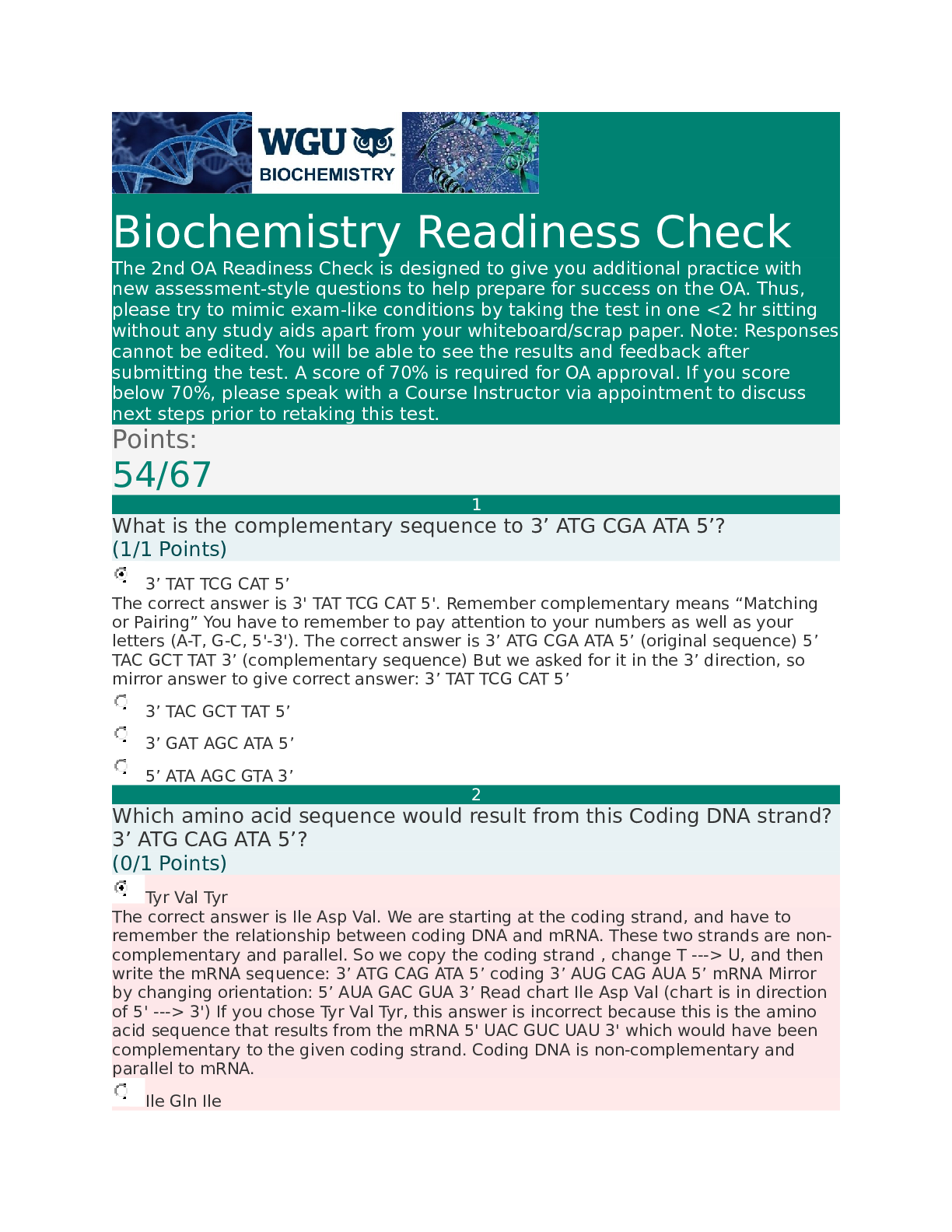
Reviews( 1 )

by Bobweiss · 3 years ago
Document information
Connected school, study & course
About the document
Uploaded On
Mar 19, 2021
Number of pages
23
Written in
Additional information
This document has been written for:
Uploaded
Mar 19, 2021
Downloads
1
Views
151

